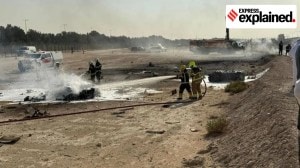Naxalism’s New Killing Fields
On March 19, 1999 the cadres of the Maoist Communist Centre (MCC), an extremist left-wing outfit, slaughtered 35 upper caste landowners in t...

On March 19, 1999 the cadres of the Maoist Communist Centre (MCC), an extremist left-wing outfit, slaughtered 35 upper caste landowners in the nondescript hamlet of Senari in Central Bihar’s Jehanabad district. Routinely reporting political killings in Bihar for a while, I was no stranger to carnages. However, my trip to Senari, soon after the mayhem left my stomach churning. The barbarity of the killing was indescribable, the methods used brutal, the tragedy heart-wrenching.
An old man, who had helplessly witnessed 14 members of his family — all younger than him — murdered had this story to relate: ‘‘The killers were hired butchers from Palamau (district in Jharkhand) who practise slaughter of animals every day. While the cadres would hold the victim from behind, the butchers would slit the throat with a scythe, just as they sacrifice goats during offerings. Yet, even the professional butchers were overwhelmed with the number of throats they had to slit. One of the assassins who killed most of my family members confessed to a colleague: ‘I know we have to kill one hundred people, but I am so disgusted with slitting human throats that I need to throw up first.’ That is how I was freed, the killer tired of butchering, told me ‘Just run away old man, your time has not yet come’.’’
Each person that I met that afternoon in Senari had an equally tragic story to tell. I next came across a 20-year-old woman who had turned dumb out of grief. She had lost her second husband in the assassination; her first husband (the elder brother of the second) was killed a few months ago. Her in-laws, who had lost both their sons in less than a year, narrated the gory tale of the killing even as they contemplated the misery that awaited their twice-widowed daughter-in-law. All the while she listened attentively without even batting an eyelid. Her silence sounded ominous and told the tale of the doom more loudly and graphically than the numerous other grotesque stories I heard that day.
Changing contours of Naxalism
Recounting the stories today is instructive since it describes the inhuman depths to which the phenomena, loosely described as the Naxalite movement, has meanwhile sunk. Dreamt and conceptualised in the late 1960s in north Bengal as ‘‘a liberation struggle, a new democratic revolution to attain freedom for the poor and downtrodden’’, the original movement has transformed beyond recognition, as have the ideology, the strategies, and the social support base.
Even during the Charu Mazumdar-led adventurist phase (1969-75), when ‘‘class annihilation’’ was practiced as an official strategy against ‘‘landlords and the compradore bourgeoisie,’’ the violent ‘‘professional revolutionaries’’ would never have hired butchers from Palamau to carry out the assassinations. Today, the two units outlawed under POTA — the MCC and the PWG — are little more than extremist gangs bordering on criminality. They make a living either out of assassinations or by abducting officials and claiming ransom. The original CPI(ML) has broken up into several groups and factions, most of them eschewing the Charu strategy in favour of mass-based agitational politics, including contesting elections. However, they have been relegated to the margins, while it is the MCC and the PWG that dominate the centrestage of left wing extremism.
According to one official estimate, between 1976 and 2002, Bihar alone witnessed approximately 100 carnages and thousands of deaths. Most of the killings were carried out either by various Naxalite outfits or by senas, private armies of landowners. The average number of killings per year runs into several hundreds in Andhra Pradesh. In the last three years since some new states have been formed, 130 police personnel have been killed in Jharkhand, 45 in Chhattisgarh.
A report of the Parliamentary Standing Committee on home affairs tabled in Parliament recently admits: ‘‘In 2002, a sudden spurt has been witnessed in the level of violence by left wing extremists. During the year, 1465 incidents of violence have been reported as against 1208 incidents in 2001.’’ The report argues that left wing extremism has spread to newer areas ‘‘such as North Chhattisgarh, western districts of West Bengal, parts of north Bihar, eastern UP and eastern and southern Jharkhand. In all, 53 districts in nine states of the country are under the sway of this movement.’’
Other than the shifting geographical contours, the movement has changed a great deal in terms of ideology and its social base. The procrustean framework of class analysis has been rejected and replaced by caste analysis greatly dependent on regional variations. Both in highly literate Kerala as well in least literate Bihar, the movement is searching for a new social base among Dalits, tribals and backward castes. In Andhra, the new PWG chief Ganapathy is a Dalit. The main reason for such a shift are twofold: first, the increasing identity politics in north India around castes and communities; second, the inability of Naxalism to attract the new generation of career-oriented students. Therefore, the new forms of Naxalism have stooped down to recruiting butchers for its killing fields.
What has not changed
ARGUABLY, Naxalism has spread to newer areas and found a base among newer constituents but what continues to remain the same is the strong correlation between concentrations of left wing extremism and poverty zones. It is precisely in the weak governance states that the movement is gaining ground. It is perhaps the knowledge of this essential link that forced the Ministry of Home Affairs to send a proposal to the Planning Commission for the inclusion of the 53 affected districts in its new scheme of ‘Backward District Initiative’. However, the standing committee report admits that the ‘‘strategy does not seem to be yielding results… and the bottom line is that the problem is gradually spiralling’’. Reason says the report: do not treat it purely as a law and order issue, strike at its socio-economic roots.
Clearly, policing alone, and arresting innocents under POTA will not solve the problem. The Andhra government had last year begun engaging the extremist groups in a dialogue. The Chhattisgarh government seems to have recently considered the plan to initiate dialogue with the left wing extremists as well. However, until and unless problems of weak governance are tackled, and social inequality addressed, left wing extremism will continue to (as it has in the last three decades), as the report points out ‘‘strike the right chord with the people.’’



- 01
- 02
- 03
- 04
- 05




























